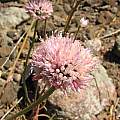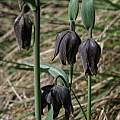The Regional Parks Botanic Garden is situated in Tilden Regional Park's beautiful Wildcat Canyon in the heart of the north Berkeley Hills in northern California. The garden is devoted to the collection, growth, display, and preservation of the native plants of California. The garden is open to the public all but three days of the year.
Allium amplectens is common in hot dry openings west of the Sierra Nevada in California and occasionally in Oregon and Washington. Photo from Nhu Nguyen.
Allium cratericola is a lovely little onion restricted to California. Photo 1-2 were taken by Nhu Nguyen.
Allium hyalinum is found in grasslands moist in the spring in the central and southern Sierra foothills. Photo from Nhu Nguyen.
Allium jepsonii is a Californian species that grows in the Sierra Nevada foothills in two different areas, one on serpentine in the north and the other on volcanic soils in the central foothills. Photo by Nhu Nguyen.
Allium sanbornii is a large onion restricted to the Sierra Nevada and southern Cascade foothills of California that is only found on serpentine outcrops. Photos by Nhu Nguyen.
Brodiaea californica is endemic to California and is found growing in light woods and open meadows in Northern California. Photos from Nhu Nguyen.
Brodiaea insignis is known from approximately twenty populations in the watersheds of the Tule and Kaweah Rivers in Tulare county, California, occurring in clay soil on granitic substrate in valley grassland and foothill woodland. The photo below was taken by Nhu Nguyen.
Brodiaea terrestris is a coastal bluff and coastal prairie plant with stems appearing to be half buried beneath the soil. It grows from California to Oregon. The photo below taken by Nhu Nguyen was labeled as Brodiaea minor but is probably this species.
Calochortus amabilis is found on open hillsides and in open woodlands in the Coast Ranges of California. Photo by Nhu Nguyen with a pink Lewisia rediviva in the background.
Calochortus monophyllus is a woodlands species from the western foothills of the Sierra Nevada. Photos below were taken by Nhu Nguyen.
Calochortus palmeri var. munzii is found in the San Jacinto Mountains of Riverside County California. Photo taken by Nhu Nguyen.
Calochortus plummerae is a southern California species that grows in rocky clay soil often found with its base shaded and flowers in sun. Photos were taken by Nhu Nguyen.
Delphinium bakeri is an endangered species now known only from one remaining tiny population near Salmon Creek in Sonoma County, where only seven plants remained as of March, 2006. The photos below were taken by Nhu Nguyen.
Delphinium luteum is a very rare species found in only two places on the coastal bluffs of Sonoma County California.The photos below were taken by Nhu Nguyen at the Tilden Botanic Garden.
Fritillaria affinis var. tristulis is rare and found only along the north coast of California in Marin County. Photos 1-4 were taken by Nhu Nguyen.
Fritillaria liliacea is native to coastal areas of Northern California (mostly San Francisco Bay Area) where it grows in clay soils in full sun. Photos 1-2 were taken by Nhu Nguyen.
Fritillaria ojaiensis is a rare plant restricted to shady rocky slopes and river basins in San Luis Obispo, Santa Barbara and Ventura counties. Photos 1-5 were taken by Nhu Nguyen.
Fritillaria purdyi is a rare northern California species often found growing in serpentine ridges in chaparral and grasslands where it has little competition. The photos below were taken by Nhu Nguyen.
Iris bracteata is a species that grows in shaded sites in dry pine forest, or in meadows in the shade of large shrubs or bracken ferns in the Siskiyou Mountains of California and southern Oregon. Photos 1-2 taken by Bob Rutemoeller and Mary Sue Ittner April 2012.















































